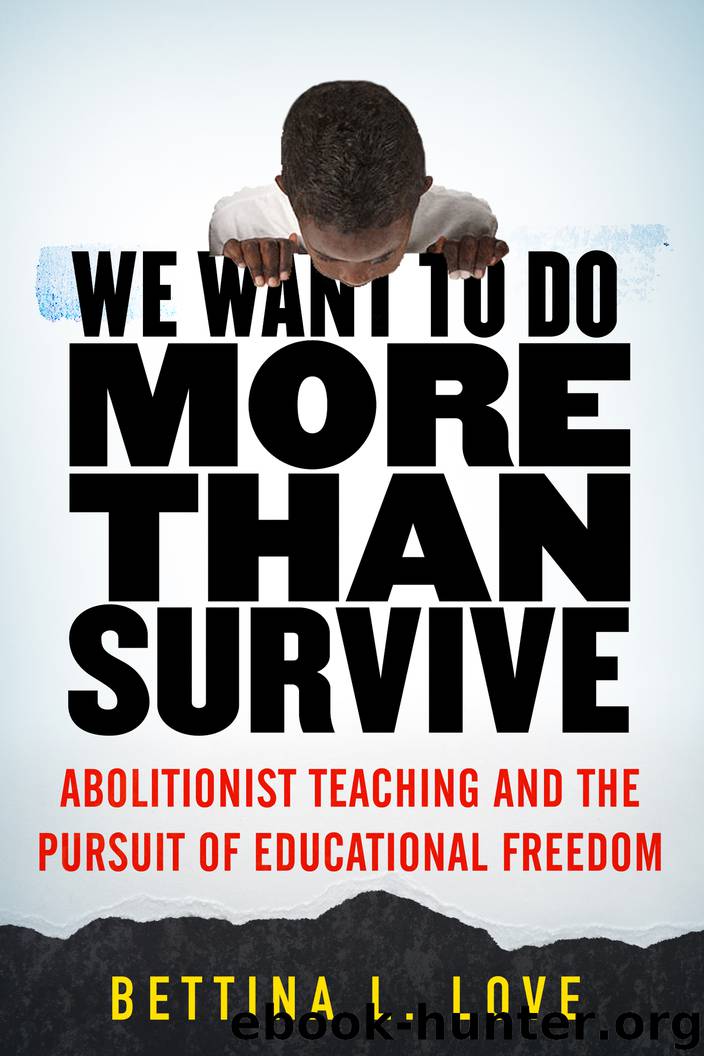We Want to Do More Than Survive by Bettina Love

Author:Bettina Love
Language: eng
Format: epub
Publisher: Beacon Press
CONGO SQUARE
As mentioned above, there is one more place on American soil where I feel the creativity, imagination, and ingenuity of free and enslaved dark folx who created art for Black joy with the beauty, love, and sophistication of darkness: Congo Square in New Orleans. Congo Square is a plot of land on North Rampart Street between St. Ann and St. Peter streets, currently nestled inside a park named after the great jazz musician Louis Armstrong. The park is located in the oldest Black community in New Orleans, Tremé.
Before Louis Armstrong ever blew his trumpet or the first notes of jazz were composed, there was Congo Square. For more than a century starting in the mid-1700s, enslaved Africans, free Blacks, and Native Americans were allowed to gather under the French code noir, which permitted worship and the selling of goods by enslaved human beings, but only on the Sabbath. Before the French arrived, the land was home to the Houmas Indians. On Sundays, festivals were organized around African and Afro-Caribbean dances, drums, songs, and the trading of goods. Enslaved Africans gathered, as many as six hundred on any given Sunday, to remember, to recall, and to honor what they were told and what they were forced to forget. What was created at Congo Square was the blending of sounds from Africa, the Caribbean, and Europe to form African American cultural expressions such as jazz, scatting, and swing. The rhythmic motifs, polyrhythmic sophistication, and complex, free-form yet structured improvisations of African music—combined with European instruments like the trumpet, bass, and snare drums—marked the sonic start of jazz. Arguably, there would be no jazz music without these incredible weekly gatherings at Congo Square.
But Congo Square is more than music; it’s where personal and communal healing happened, where Black joy was found, and where resistance could be expressed in art. Social change cannot happen without art for joy and resistance. At Congo Square, enslaved Africans, Native Americans, and free Black folx shared the joy of their cultures, if only for a day. Even if they knew pain would follow on Monday morning, on Sundays they were using joy, love, and creativity as radical tools for Black expression and healing. Congo Square was a place to heal, recharge, and freedom-dream. They danced and sang together in a space cultivated by their cultures and they refused to let go. Education researcher and Black feminist Cynthia Dillard reminds us, “All too often, we have been seduced into forgetting (or have chosen to do so), given the weight and power of our memories and the often radical act of (re)membering in our present lives and work, that is (re)membering as an act of decolonization.”11 Abolitionist teaching is dependent on spaces like Congo Square to create art for resistance, art for (re)membering, art for joy, art for love, art for healing, and art for humanity.
Download
This site does not store any files on its server. We only index and link to content provided by other sites. Please contact the content providers to delete copyright contents if any and email us, we'll remove relevant links or contents immediately.
| Administration | Assessment |
| Educational Psychology | Experimental Methods |
| History | Language Experience Approach |
| Philosophy & Social Aspects | Reform & Policy |
| Research |
The Art of Coaching Workbook by Elena Aguilar(48384)
Trainspotting by Irvine Welsh(20099)
Twilight of the Idols With the Antichrist and Ecce Homo by Friedrich Nietzsche(17728)
Fangirl by Rainbow Rowell(7856)
Periodization Training for Sports by Tudor Bompa(7348)
Change Your Questions, Change Your Life by Marilee Adams(6675)
This Is How You Lose Her by Junot Diaz(5810)
Grit by Angela Duckworth(4753)
Red Sparrow by Jason Matthews(4696)
Asking the Right Questions: A Guide to Critical Thinking by M. Neil Browne & Stuart M. Keeley(4612)
Paper Towns by Green John(4183)
Room 212 by Kate Stewart(4125)
Ken Follett - World without end by Ken Follett(3985)
The Sports Rules Book by Human Kinetics(3605)
Housekeeping by Marilynne Robinson(3428)
The Motorcycle Diaries by Ernesto Che Guevara(3353)
Introduction to Kinesiology by Shirl J. Hoffman(3309)
Exercise Technique Manual for Resistance Training by National Strength & Conditioning Association(3308)
Double Down (Diary of a Wimpy Kid Book 11) by Jeff Kinney(3292)
